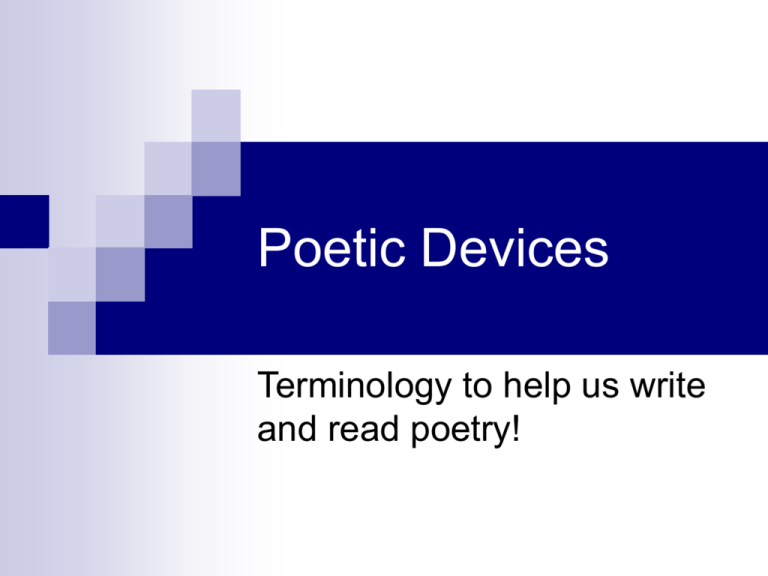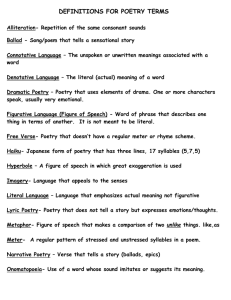Poetic Devices
advertisement

Poetic Devices Terminology to help us write and read poetry! Figurative Language Figurative language: writing not meant to be interpreted literally Ex: My eyes are on fire! VS. Literal language: the explicit or primary meaning (surface level/plot) Ex: My eyes are irritated. More Figurative Language… Hyperbole: deliberate exaggeration or overstatement Ex: Her mouth was as big as the Grand Canyon Oxymoron: words used together that actually contradict in meaning. Ex: jumbo shrimp, old news, freezer burn More Figurative Language… Metaphor: a direct comparison of two nonlike things for an effect “something is something” Ex: She is a bomb, and she exploded in my heart. Personification: giving human traits and qualities to non-human objects. Ex: The sunflowers stretched toward the sun and smiled happily. More Figurative Language… Simile: a comparison using like or as Ex: my love is like a red, red rose… she is as cute as a button Sensory Language Sensory language: language that appeals to the senses Ex: The gravel crunched underneath my shredding sneaker. Wafts of acidic air penetrated my nostrils, crawling down my throat and stifling my breath. I could taste the rancid garbage as I walked by the dumpster. My frozen hand struggled to form a tighter grip around my bag. More Sensory Language… Imagery: the use of pictures, figures of speech, or description to evoke actions, ideas, objects, or characters Alliteration: repetition of initial/beginning consonant sounds Ex: We walked with Wes on Wednesday. More Sensory Language… Assonance: close repetition of similar vowel sounds within words Ex: The flat slap of hands Consonance: close repetition of consonant sounds in words (pitter patter butter) More Sensory Language… Onomatopoeia: a word whose sound suggests its meaning – imitates sound Ex: Eww! Ugh! Moo. Tick-tock! Lyric poetry: musical verse which expresses a single speaker’s thoughts or feelings on a subject Form-Structure Stanza: a group of lines in a poem considered as a unit (the poem’s version of a paragraph) Free verse: poetry with varying rhythm and rhyme Form-Structure Concrete poetry: a poem with a shape that suggests its subject or the movement of its subject Dove Enjambment: when the meaning of a poem extends from one line to the next. Ex. She walked upstairs and fell flat on the floor Form-Structure Refrain: stanza repeated for emphasis (often in songs or lyric poetry) Haiku: three lined Japanese verse form 1st and 3rd lines – 5 syllables 2nd line – 7syllables Form-Structure Sonnet: 14 line poem focused on a single theme Shakespearean sonnet: 14 line poem 3 quatrains (4 lines) and a couplet (2 lines) --rhyme scheme abab cdcd efef gg Form-Rhythm/Rhyme rhyme scheme: regular pattern of rhyming words in a poem (indicated by letter notation) Ex: some say the world will end in fire a some say ice b from what I’ve tasted of desire a I hold with those who favor fire a but if I had to perish twice… b Form-Rhythm and Rhyme End rhyme: when rhyming words are repeated at the end of a line Ex: Whose woods these are I think I know, His house is in the village, though; Internal rhyme: when rhyming words fall within a line Ex: Once upon a midnight dreary, while I pondered weak and weary Form-Rhythm and Rhyme Half rhyme: Consonance on the last consonants of two words. Ex: Fill and shell. Couplet: a pair of rhyming lines Ex: Twinkle, twinkle little star How I wonder what you are Form-Rhythm/Rhyme Rhythm: the pattern of beats, or stresses, in a line of poetry Meter: regular or repeated rhythm pattern in a poem. Form-Rhythm and Rhyme Iambic pentameter: a line of poetry with 5 iambic feet, each with one unstressed syllable followed by a stressed syllable. Ex: u / u / u / u / u / I went / up town / to buy / a loaf / of bread Shakespeare’s Sonnet 60 Like as the waves make towards the pebbled shore, So do our minutes hasten to their end, Each changing place with that which goes before, In sequent toil all forwards do contend. Nativity, once in the main of light, Crawls to maturity, wherewith being crowned, Crooked eclipses 'gainst his glory fight, And Time that gave doth now his gift confound. Time doth transfix the flourish set on youth, And delves the parallels in beauty's brow, Feeds on the rarities of nature's truth, And nothing stands but for his scythe to mow. And yet to times in hope my verse shall stand Praising thy worth, despite his cruel hand Responding to Poetry Context: the circumstances surrounding the poem, such as: Information about the author Historical information relating to the poem The time and place in which the poem was written allusion: a reference to a well-known person, place, event, literary work, or work of art Responding to Poetry POINT OF VIEW: The position of the speaker in relation to the events, ideas, or details of the poem Performing Poetry Punch A punch is an extra stress or emphasis on a particular word. Use this to add an extra “kick.” The waves crashed on the shore. Her smile, tearing my heart Performing Poetry Pause A pause is a brief rest following a particular word. It allows the previous word to set in and gives the listening time to think about its meaning. EX: Sunrise fills me with hope (pause) Her eyes (pause), bright blue orbs shining down the hall Performing Poetry When to Pause? Line breaks Punctuations (periods, commas, dashes, etc.) Any place you’d like to add emphasis Paint Painting is expressing a certain emotion that fits with the meaning of the word, such as saying the word “fun” in a happy voice. EX: Anger swallows me EX: Winning shot brings pure joy





